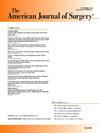Nomogram-based prediction of postoperative seroma in elderly patients undergoing ambulatory hernia repair
IF 2.7
3区 医学
Q1 SURGERY
引用次数: 0
Abstract
Background
This study aimed to explore potential risk factors associated with the occurrence of postoperative seroma in elderly patients after ambulatory hernia surgery and to construct a prediction model.
Methods
This study consecutively included elderly patients who underwent ambulatory Lichtenstein tension-free hernioplasty for inguinal hernia from 2021 to 2024. The receiver operating characteristic (ROC) curves were used to assess the predictive and optimal cut-off points of continuous variables. Multivariate regression analysis was used to identify independent risk factors. Based on the identified factors, a nomogram model was further constructed and evaluated using R.
Results
A total of 340 patients were enrolled in this study, and 35 cases (10.3 %) developed seroma within three months post-surgery. Body mass index (BMI) ≥ 24.0 (OR: 2.65, 95 %CI: 1.15–6.14, P = 0.023), taking anticoagulant drug (OR: 3.04, 95 %CI: 1.31–7.03, P = 0.009),systemic immune-inflammation index (SII) ≥ 892.5 (OR: 8.34, 95 %CI: 3.44–20.21, P < 0.001), and prognostic nutritional index (PNI) < 50.4 (OR: 5.54, 95 %CI: 1.87–16.41, P = 0.002) were four independent risk factors for seroma by the logistic regression analysis. The AUC of the nomogram based on these four indicators was 0.848, with a sensitivity of 0.751 and a specificity of 0.829. The external validation from another center indicated that the nomogram model acts well with an AUC of 0.903.
Conclusions
The nomogram model based on BMI, anticoagulant drug use, SII, and PNI possesses well predictive capabilities for postoperative seroma after ambulatory hernia surgery.
基于nomogram预测老年门诊疝修补术后血清肿的研究
本研究旨在探讨老年患者门诊疝术后血清肿发生的潜在危险因素,并建立预测模型。方法本研究连续纳入2021 - 2024年行门诊利希滕斯坦无张力疝成形术治疗腹股沟疝的老年患者。采用受试者工作特征(ROC)曲线评估连续变量的预测和最佳截止点。采用多因素回归分析确定独立危险因素。结果共纳入340例患者,其中35例(10.3%)在术后3个月内发生血肿。经logistic回归分析,体重指数(BMI)≥24.0 (OR: 2.65, 95% CI: 1.15 ~ 6.14, P = 0.023)、服用抗凝药物(OR: 3.04, 95% CI: 1.31 ~ 7.03, P = 0.009)、全身免疫炎症指数(SII)≥892.5 (OR: 8.34, 95% CI: 3.44 ~ 20.21, P < 0.001)、预后营养指数(PNI) < 50.4 (OR: 5.54, 95% CI: 1.87 ~ 16.41, P = 0.002)是血清血瘤发生的4个独立危险因素。基于这四个指标的nomogram AUC为0.848,sensitivity为0.751,specificity为0.829。另一中心的外部验证表明,nomogram model的AUC为0.903。结论基于BMI、抗凝药物使用、SII和PNI的nomogram model对疝术后血肿有较好的预测能力。
本文章由计算机程序翻译,如有差异,请以英文原文为准。
求助全文
约1分钟内获得全文
求助全文
来源期刊
CiteScore
5.00
自引率
6.70%
发文量
570
审稿时长
56 days
期刊介绍:
The American Journal of Surgery® is a peer-reviewed journal designed for the general surgeon who performs abdominal, cancer, vascular, head and neck, breast, colorectal, and other forms of surgery. AJS is the official journal of 7 major surgical societies* and publishes their official papers as well as independently submitted clinical studies, editorials, reviews, brief reports, correspondence and book reviews.

 求助内容:
求助内容: 应助结果提醒方式:
应助结果提醒方式:


